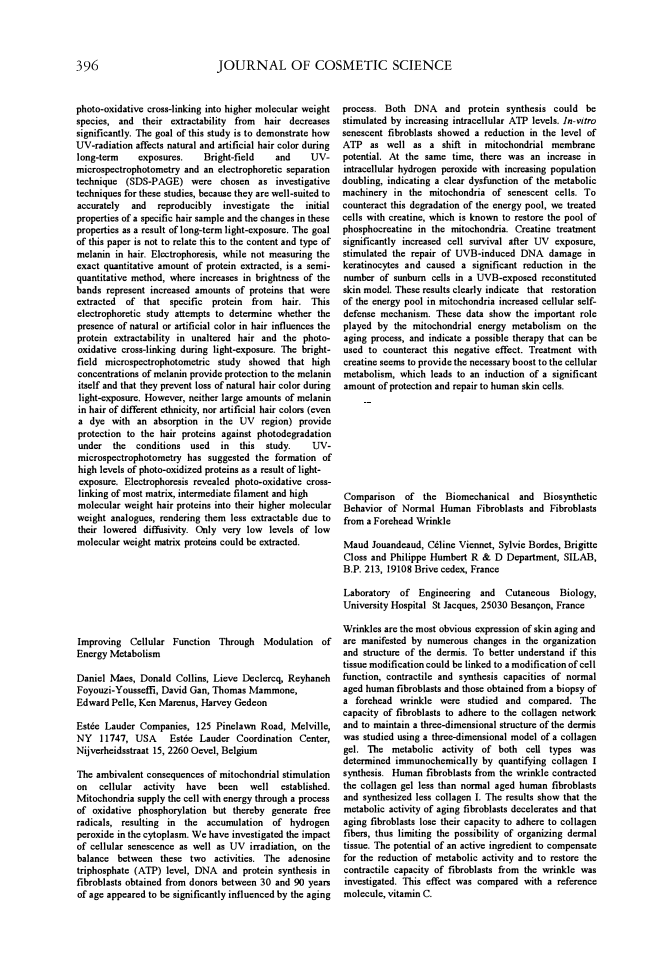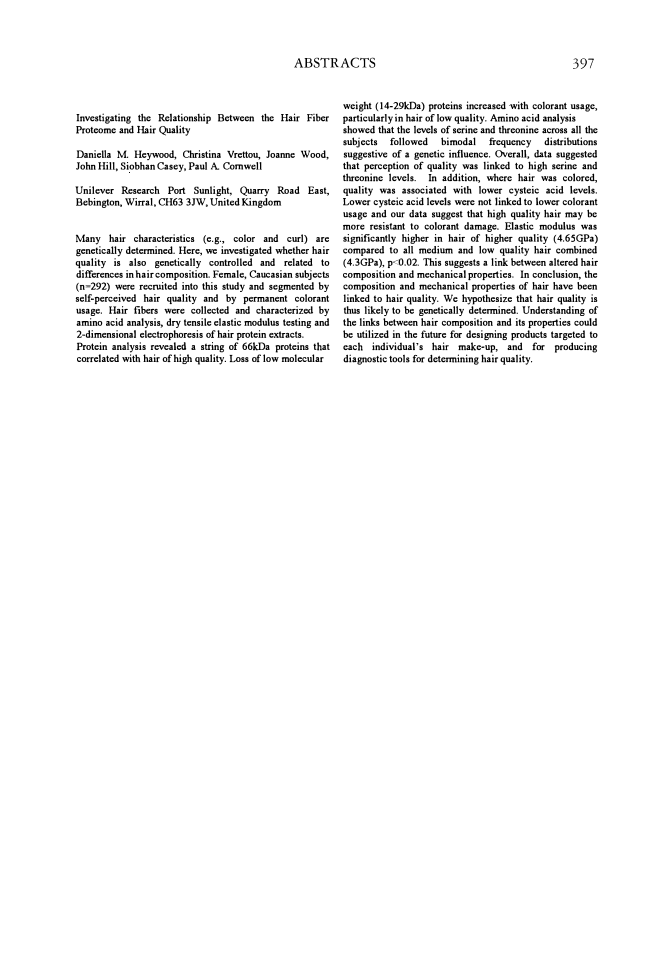396 JOURNAL OF COSMETIC SCIENCE photo-oxidative cross-linking into higher molecular weight species, and their extractability from hair decreases significantly. The goal of this study is to demonstrate how UV-radiation affects natural and artificial hair color during long-term exposures. Bright-field and UV microspectrophotometry and an electrophoretic separation technique (SDS-PAGE) were chosen as investigative techniques for these studies, because they are well-suited to accurately and reproducibly investigate the initial properties of a specific hair sample and the changes in these properties as a result of long-term light-exposure. The goal of this paper is not to relate this to the content and type of melanin in hair. Electrophoresis, while not measuring the exact quantitative amount of protein extracted, is a semi quantitative method, where increases in brightness of the bands represent increased amounts of proteins that were extracted of that specific protein from hair. This electrophoretic study attempts to determine whether the presence of natural or artificial color in hair influences the protein extractability in unaltered hair and the photo oxidative cross-linking during light-exposure. The bright field microspectrophotometric study showed that high concentrations of melanin provide protection to the melanin itself and that they prevent loss of natural hair color during light-exposure. However, neither large amounts of melanin in hair of different ethnicity, nor artificial hair colors (even a dye with an absorption in the UV region) provide protection to the hair proteins against photodegradation under the conditions used in this study. UV microspectrophotometry has suggested the formation of high levels of photo-oxidized proteins as a result of light exposure. Electrophoresis revealed photo-oxidative cross linking of most matrix, intermediate filament and high molecular weight hair proteins into their higher molecular weight analogues, rendering them less extractable due to their lowered diffusivity. Only very low levels of low molecular weight matrix proteins could be extracted. Improving Cellular Function Through Modulation of Energy Metabolism Daniel l\faes, Donald Collins, Lieve Declercq, Reyhaneh Foyouzi-Yousseffi, David Gan, Thomas l\fammone, Edward Pelle, Ken Marenus, Harvey Gedeon Estee Lauder Companies, 125 Pinelawn Road, Melville, NY 11747, USA Estee Lauder Coordination Center, Nijverheidsstraat 15, 2260 Oevel, Belgium The ambivalent consequences of mitochondrial stimulation on cellular activity have been well established. Mitochondria supply the cell with energy through a process of oxidative phosphorylation but thereby generate free radicals, resulting in the accumulation of hydrogen peroxide in the cytoplasm. We have investigated the impact of cellular senescence as well as UV irradiation, on the balance between these two activities. The adenosine triphosphate (ATP) level, DNA and protein synthesis in fibroblasts obtained from donors between 30 and 90 years of age appeared to be significantly influenced by the aging process. Both DNA and protein synthesis could be stimulated by increasing intracellular ATP levels. In-vitro senescent fibroblasts showed a reduction in the level of ATP as well as a shift in mitochondrial membrane potential. At the same time, there was an increase in intracellular hydrogen peroxide with increasing population doubling, indicating a clear dysfunction of the metabolic machinery in the mitochondria of senescent cells. To counteract this degradation of the energy pool, we treated cells with creatine, which is known to restore the pool of phosphocreatine in the mitochondria. Creatine treatment significantly increased cell survival after UV exposure, stimulated the repair of DVB-induced DNA damage in keratinocytes and caused a significant reduction in the number of sunburn cells in a DVB-exposed reconstituted skin model. These results clearly indicate that restoration of the energy pool in mitochondria increased cellular self defense mechanism. These data show the important role played by the mitochondrial energy metabolism on the aging process, and indicate a possible therapy that can be used to counteract this negative effect. Treatment with creatine seems to provide the necessary boost to the cellular metabolism, which leads to an induction of a significant amount of protection and repair to human skin cells. Comparison of the Biomechanical and Biosynthetic Behavior of Normal Human Fibroblasts and Fibroblasts from a Forehead Wrinkle Maud Jouandeaud, Celine Viennet, Sylvie Bordes, Brigitte Closs and Philippe Humbert R & D Department, SILAB, B.P. 213, 19108 Brive cedex, France Laboratory of Engineering and Cutaneous Biology, University Hospital St Jacques, 25030 Besam on, France Wrinkles are the most obvious expression of skin aging and are manifested by numerous changes in the organization and structure of the dermis. To better understand if this tissue modification could be linked to a modification of cell function, contractile and synthesis capacities of normal aged human fibroblasts and those obtained from a biopsy of a forehead wrinkle were studied and compared. The capacity of fibroblasts to adhere to the collagen network and to maintain a three-dimensional structure of the dermis was studied using a three-dimensional model of a collagen gel. The metabolic activity of both cell types was determined immunochemically by quantifying collagen I synthesis. Human fibroblasts from the wrinkle contracted the collagen gel less than normal aged human fibroblasts and synthesized less collagen I. The results show that the metabolic activity of aging fibroblasts decelerates and that aging fibroblasts lose their capacity to adhere to collagen fibers, thus limiting the possibility of organizing dermal tissue. The potential of an active ingredient to compensate for the reduction of metabolic activity and to restore the contractile capacity of fibroblasts from the wrinkle was investigated. This effect was compared with a reference molecule, vitamin C.
ABSTRACTS 397 Investigating the Relationship Between the Hair Fiber Proteome and Hair Quality Daniella M. Heywood, Christina Vrettou, Joanne Wood, John Hill, Siobhan Casey, Paul A Cornwell Unilever Research Port Sunlight, Quarry Road East, Bebington, Wirral, CH63 3JW, United Kingdom Many hair characteristics (e.g., color and curl) are genetically determined. Here, we investigated whether hair quality is also genetically controlled and related to differences in hair composition. Female, Caucasian subjects (n=292) were recruited into this study and segmented by self-perceived hair quality and by permanent colorant usage. Hair fibers were collected and characterized by amino acid analysis, dry tensile elastic modulus testing and 2-dimensional electrophoresis of hair protein extracts. Protein analysis revealed a string of 66kDa proteins that correlated with hair of high quality. Loss of low molecular weight (14-29kDa) proteins increased -with colorant usage, particularly in hair of low quality. Amino acid analysis showed that the levels of serine and threonine across all the subjects followed bimodal frequency distributions suggestive of a genetic influence. Overall, data suggested that perception of quality was linked to high serine and threonine levels. In addition, where hair was colored, quality was associated with lower cysteic acid levels. Lower cysteic acid levels were not linked to lower colorant usage and our data suggest that high quality hair may be more resistant to colorant damage. Elastic modulus was significantly higher in hair of higher quality (4.65GPa) compared to all medium and low quality hair combined (4.3GPa), p0.02. This suggests a link between altered hair composition and mechanical properties. In conclusion, the composition and mechanical properties of hair have been linked to hair quality. We hypothesize that hair quality is thus likely to be genetically determined. Understanding of the links between hair composition and its properties could be utilized in the future for designing products targeted to each individual's hair make-up, and for producing diagnostic tools for determining hair quality.
Purchased for the exclusive use of nofirst nolast (unknown) From: SCC Media Library & Resource Center (library.scconline.org)






































































































